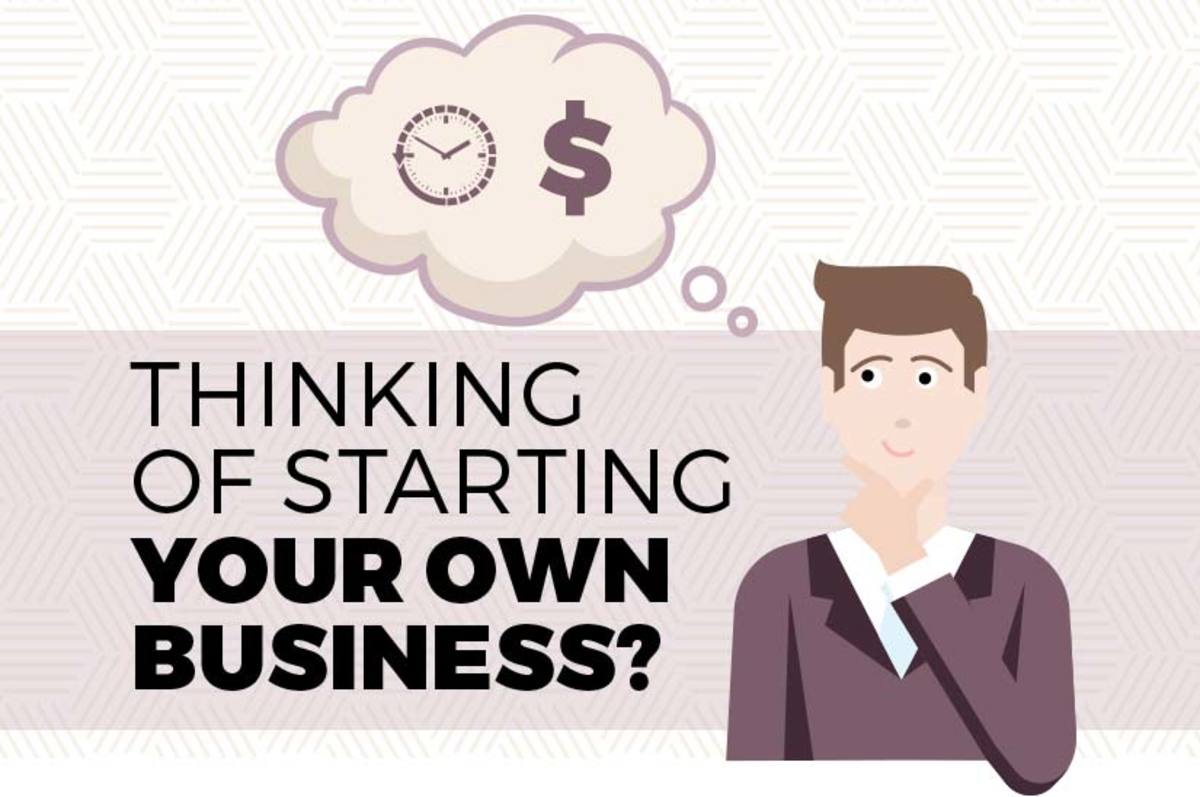- HubPages»
- Business and Employment»
- Small Businesses & Entrepreneurs»
- Entrepreneurship
How to Start a Business - Step by Step

Introduction
How such a simple title can be such a hard process is a wonder. Starting a business, if done correctly, can be time consuming and costly. Sure, anyone can just open up shop without much planning, but eventually that person will be dealing with multiple federal, state, and local agencies wanting, at the very least, information. The purpose of this article is to take my thirty plus years working with businesses and my experience setting up several businesses and write down all the steps that need to be done. Notice I did not say running a business. That is another completely different issue.
1. Step number one in starting a business is thinking; determining something you like to do and are good at doing. Those two requirements are not the same and both are necessary. You must enjoy the activity of the business because you will commit a large amount of time doing it. Very, very few businesses are popular quickly. Unless you have a lot of money and can hire several people right away, when you open your business, you will do everything. The amount of work will get old and, if you do not enjoy it, you will be leaving your business and be poorer for it. You must also be good at doing the activity of the business. If you are not good, you will not find a way to be better than your competitors.
2. The second step is determining a name for your business. Your name must be short, but memorable. It should be something people can say easily without having to get a speech therapist. But most importantly, it must be unique. Most states will not let you use a business name that someone else is using in the state. Some business names have a trademark with the federal government, so you do not want to even be close to those. Pick something that is original and can be linked to your business activity. This is an important step since this name will occur on everything that will happen hereafter.
3. Begin working on a marketing plan for your business. This plan will be continuously improved until you are ready to implement it. There are some things to note. Do not try to market to everyone; you will only waste your money. Figure out the characteristics of people who would most likely be your customer. Once you have a couple groups of potential customers and know their characteristics, develop your marketing to target them. Know what they listen to one the radio, what they watch on TV, what they read, and where they go. Those are places where you want to market to attract their attention. You will get the most use of your advertising money by doing this.

4. At the same time as the previous point, you should be looking at all your competitors and finding out what their strengths and weaknesses are. Knowing these will help you come up with a strategy for getting into the market and serving people your competitors are missing.
5. In this step you need to find a temporary location for the business at which to receive mail. It could be as simple as your personal residence or a post office box. Every form that you complete will need a mailing address. Do not worry about using your personal address. You can change this later, but you need something now for the important mail that is about to start flowing.
6. Now you need to decide on the legal entity for the business. There are sole proprietorships, partnerships, limited liability corporations, subchapter S corporations, and subchapter C corporations from which to choose. The choice will depend much upon what you want to do with the business, the types of benefits you would like to have (even if it is in the future), and who is going to own the business. Once you decide this, you may need to make the proper filings with your state’s Secretary of State office and possibly even with the federal government. Some states require an attorney or a CPA to sign off on the state documents, so there will be a cost here in addition to the fees the state charges for the filings. Keep track of all expenses to provide to the person preparing your financial statements. The Secretary of State’s Office will also do a name search to see if your business name is unique enough. If not, it will cause delays in processing the paperwork. This step must be completed before continuing to the next steps.
7. File for an Employer Identification Number (EIN) with the US Government. This can be done online, but you need all the information from the previous step. If you choose to do it online, you will get a number very quickly. Make sure you keep copies of the documents the IRS sends you; you may be required to prove your EIN in subsequent steps.
8. You can now open your first bank account(s) if you have money you are putting into the company. The bank will need to see all the paperwork from the Secretary of State’s Office and the EIN document. They may also require some of your personal information. Please keep records from where the money is coming for the person preparing your financial statements.
9. At this point it would be good to find a permanent location. Finding the location now means that when you file for your permits and licenses, you are not having to worry about changing locations from the temporary location to the permanent one. Sometimes changing this address may mean having to reapply for permits or licenses, making the old ones worthless. Save yourself some time and money and get the permanent location first.

10. In this step you need to apply for all the permits and licenses you need for the business. Depending on what you want to do, there may be permits or licenses at the federal level, the state level, the county level, and even the city level. This is where you must take your time and research what is needed to conduct your business. Failure to take care of this step properly will eventually lead to major problems with one or multiple governmental agencies. If you are going to have employees, you will also need to register for withholding permits in your state as well as register with the unemployment office of the state. If you must charge your customers sales tax, you will need to register with the department of revenue of all the states where the sales transactions will be made. Take special care in this step to do everything properly; mistakes can be a nightmare to fix.
11. Now that you have your permanent address and you are fully registered with all the governmental agencies, you can now start looking to hire employees. Employees are not necessary, but you can get much more done with more people. Also, make sure you understand the nuances of payroll and payroll deductions. You will be withholding amounts from the employees checks and possibly yours (depending upon the legal entity you chose above). Do not try hire people as independent contractors. The IRS has very specific rules on this and I have seen businesses get crushed when the IRS gets involved over this problem. Also, if you hire employees outside of the state you are in, you will need to register for withholding permits in the employees’ resident states.
12. Here you can start getting whatever supplies and inventory you need to perform your business activity. If you are waiting for a startup business loan from a financial institution, you may have to wait before starting this and the previous step.
13. Begin training your employees before opening your business. If the business is just you, then skip this step. However, you want to make sure everyone knows what they are doing before you open the doors. Failing to do this will cause customers to leave rather than come.
14. Open the doors to your business. Now the hard part begins. Notice the title is not “How to Start a Successful Business”. While some of the groundwork laid in this process can contribute toward success, what you do when you run this business will determine your success.
Concluding Remarks
These are the steps to starting a business. It is hard and often frustrating work. But if you really want to do it, this will be a good learning experience for you and can be very rewarding. Be very detailed, concise, and patient in what you do; it will help you in the long run. Get help when you need it, because doing it yourself can sometimes create problems that are not easily fixable. However, my best advise is to develop a business plan. A business plan will help you map all of this out. It will also be a guide to keep you focused through the process. If you are getting a loan, the financial institution may require one anyway. Do not skimp on any of this; it could save your business.








